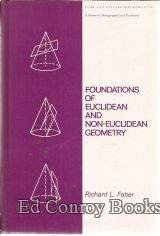
Hence, it is an abstraction of all three metric geometries (parabolic, elliptical and hyperbolic). Another notable point about this treatise is that it introduced the term absolute geometry, which refers to any geometry that relies upon the first four postulates of Euclid but makes no assumptions about parallel lines whatsoever. This was published in 1832, thereby punching through the floodgate and forcing the world to recognize that geometry was not a field of study that had long since been investigated to exhaustion by the ancient Greeks. Lobachevsky's Hyperbolic Geometryįinally, in 1825 Janos Bolyai wrote a treatise that claimed the existence of hyperbolic geometry. By 1817, however, even Gauss was convinced that the parallel postulate was quite independent of the other four and had covertly begun to dabble in hyperbolic geometry, although he stopped shy of announcing his discoveries for fear that he would be labelled a maverick. He was followed in 1766 by Johann Lambert, who only succeeded in making some more interesting observations about triangles. Although he made an incorrect assumption in his proof, his failed attempt served to change the way in which this problem could be approached. This model of geometry required a hyperbolic plane, which is often depicted as a saddle-shaped surface, and leaves inviolate the first four postulates.Īlthough Saccheri intended to find a contradiction, he proved a vast array of theorems about this hyperbolic geometry without running into any inconsistencies until he eventually tripped up and used an invalid assumption to show a contradiction. The other case assumed that, given a line and a point, there could be more than one parallel (to the original line) line running through the point.

One of these cases assumed that there were no parallel lines and required a spherical plane but violated the first two postulates so was dismissed by Saccheri. By 1733 he had discovered that there were only two cases to deal with if the parallel postulate was false. The next person to try this was Saccheri in 1697. It was not until over fifteen centuries after Euclid that the Persian/Arab mathematician Nasir-Eddin thought to actually attempt disproving the parallel postulate, albeit this was only done in the hope that a proof by contradiction would result. In 1663 John Wallis inadvertently showed that it was equivalent to the statement that "to each triangle, there exists a similar triangle of arbitrary magnitude." Then in 1794 Legendre showed that it was also equivalent to the statement that "the sum of the angles of a triangle is equal to two right angles." Of course, these tangential discoveries only increased the fervour with which mathematicians sought to convert the parallel postulate into a theorem. In the process of investigating this postulate, it was inadvertently found to be equivalent to some seemingly unrelated statements about triangles. Starting with Poseidonios, Ptolemy and Proclus, a host of mathematicians attempted to remove this postulate from the required foundation for all of geometry, none of them successfully. Even Euclid himself was uncomfortable using this postulate and proved his first twenty eight propositions without invoking it.ĭespite many centuries of effort, however, nobody was able to prove the parallel postulate using only the other four. This postulate is more complex than the other four, suggesting that it could be deduced from them alone and need not be assumed true to begin with. The lone weak spot was Euclid's fifth (parallel) postulate, which can be paraphrased to state that for any line of unbounded length and a point not on this line, there is exactly one line of unbounded length that passes through the point but does not intersect the original line. Euclid intended for this compact foundation to be so obviously true that it would never be called into question.


It contains a few hundred theorems based only upon five postulates and five common notions (rules of deductive logic). Euclid's Postulates & Common NotionsĪt the turn of the third century BC the Greek Mathematician Euclid wrote a thirteen volume book called The Elements, which went on to become the bible of geometry.


 0 kommentar(er)
0 kommentar(er)
